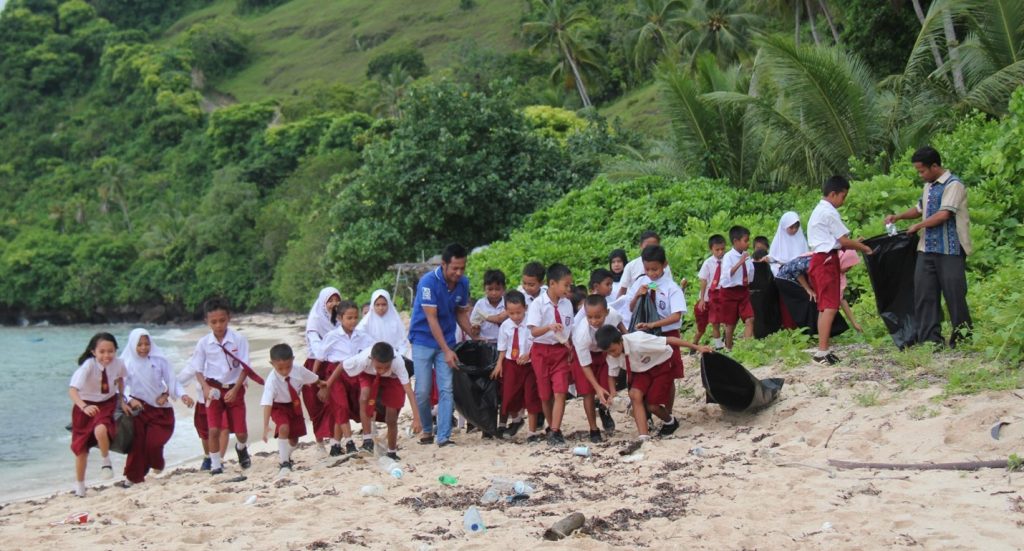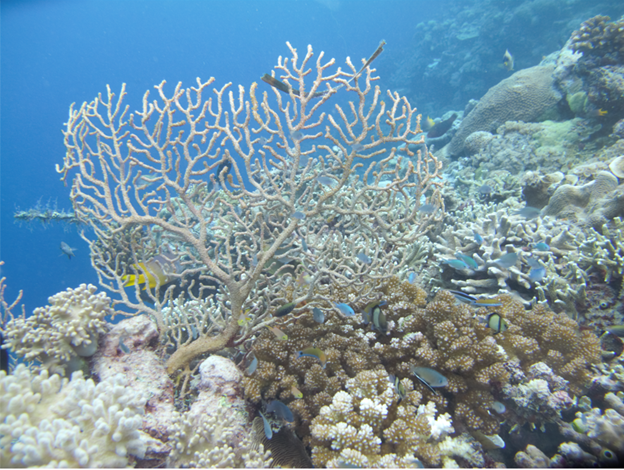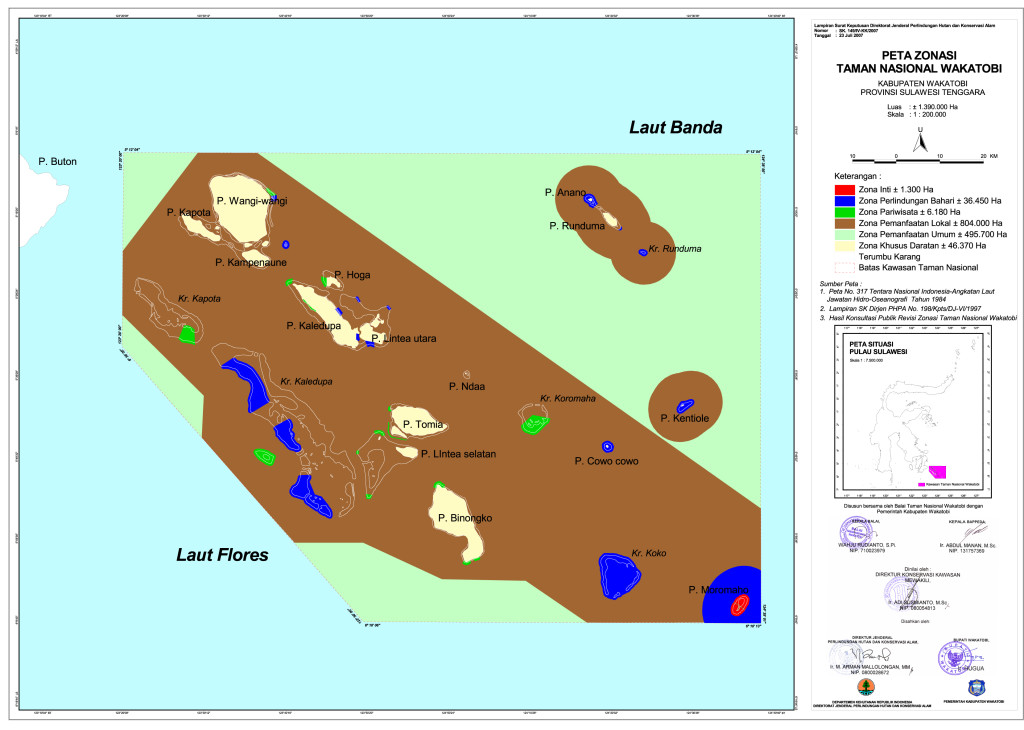Management Plan of Wakatobi National Park Leads to Increased Stakeholder Engagement Through Monitoring Efforts
Location
Wakatobi National Park, Southeast Sulawesi, Indonesia
The challenge
Wakatobi is named after the four main islands of Wangi-Wangi, Kaledupa, Tomia, and Binongko, which together with 35 smaller islands comprise the Tukang Besi Archipelago at the southeastern tip of Sulawesi, Indonesia. Located within the Coral Triangle, the area is known for its exceptional coral reef diversity and its marine resources have high economic value, particularly for fisheries. Most of the 111,402 residents of the Wakatobi district depend on the sea for their livelihood. To improve management of the reefs and surrounding waters, 3.3 million acres of islands and waters were declared as the Wakatobi National Park (WNP) in 1996.

Regular beach clean ups are carried out by youth and ecotourism groups in Tomia. These clean ups are a way to instill environmental awareness in young children. Photo © Poassa Nuhada
In addition to fisheries and coastal development related threats, elevated sea temperatures associated with El Niño/La Niña events emerged as an important threat and primary cause of severe coral bleaching. Quantitative surveys of bleaching incidence and reef resilience surveys in 2010-2011 indicated 65% corals were affected with less than 5% mortality. This low mortality indicates that the coral is resilient; however, all areas require improved zoning to include protection of sites that are highly resilient, management of herbivorous fisheries, and elimination of destructive fishing practices.
In 2019, in supporting local communities to map customary protected areas, another quantitative survey was conducted to map and to confirm the ecological values of the areas in Kaledupa and Tomia Islands. The survey results demonstrated that most of their customary protected areas possess high ecological values i.e., fish ‘bank’, coral diversity refuge, or fish nursery grounds.
A 2020 fish species and genetic morphometric analysis provided preliminary evidence that a fish currently harvested freely was Stenatherina panatelaI, a species that was customarily harvested only during a limited time, in limited areas, and with a specific catch method. Thorough research on this species has not been conducted worldwide. Although the species is not of great economic importance in other areas, in Tomia Island the species is consumed as a seasonal delicacy. Higher demand causes fishers to increasingly use nets rather than more sustainable catch methods. The research has provided the legal basis for this customary law to be widely implemented in the area, thus providing greater control for and conservation of this species.

Coral reef in Wakatobi Marine National Park of SE Sulawesi, Indonesia. Photo © Rizya Algamar/YKAN
Actions taken
By involving local communities, The Nature Conservancy (TNC) in Indonesia continues to focus on collaborative management and building a strong legal foundation for the park’s zoning and enforcement. In 2012, TNC helped facilitate the formation of a Biosphere Reserve where communities, especially indigenous groups, are seen as crucial actors.
To address threats to coral reefs and protect ecologically important sites from potential destruction, customary (adat) regulations and practices were revived. Besides the mapping of their ecologically important sites, management of the sites was also enforced by elders and customary laws. The sustainable management of certain ocean areas by the adat groups has been possible due to the issuance of Head of Regents Decree in 2019. Adat-based management has also been revitalized for the harvest of Stenatherina panatela that has been greatly exploited in recent years and whose population is in decline.
Zone types include: a core zone of no-take and no-entry, marine zone of no-take, a tourism zone of no-take which allows for only non-extractive tourism activities, and a traditional use zone dedicated for pelagic fisheries.
The community is currently involving more groups in the monitoring and surveillance of the WNP. Community-led monitoring occurs on almost all four islands where Indigenous Peoples (IPs) structures and local wisdom are present. In Wangi-Wangi and Tomia, the IPs, supported by YKAN (TNC affiliation in Indonesia), along with WNP staff, take an active role to monitor the harvest of pelagic fish (Siganus sp. and Stenatherina sp.) to protect their fish bank area in Tomia. In Kaledupa, the IPs have revitalized their local wisdom to protect mangrove areas and to manage their area to ensure octopus harvest regulations are followed. These new efforts build upon many monitoring programs in Wakatobi National Park that assess the effectiveness of the management plan, including:
- WNP Rangers record the details of resource users in the park over several days of surveys annually.
- Regular monitoring by Wakatobi National Park Authority staff to record the number and species of fish at Fish Spawning Aggregation sites and to survey turtle nesting beaches and record the species, size, and number of nesting turtles.
- Every 1-2 years, WNP rangers collect data on the condition of fish populations and coral reefs throughout the park.
- Opportunistic observations of large marine fauna (whales and dolphins) are recorded on all surveys.

Members of Indigenous Peoples institutions, WNP, and Fishery Agency of Wakatobi carried out regular monitoring of fish harvest in Tomia. Photo © Ali Hanafi/Komunto
Every two years, WNP rangers monitor seabird habitat and nesting sites, the mangrove forest, and seagrass meadow. Three surveys have been conducted to evaluate stakeholder’s perceptions on the efficiency of MPA management, and to improve the effectiveness of outreach programs by understanding trends in local perceptions.
How successful has it been?
The outcomes of the surveys conducted have led to increased support for the MPA and the zoning system. For example, one community group on Tomia Island adopted the No-take zone as their fish bank, and then encouraged local fishers to respect the rules and regulations of the No-take zone. For this effort the community group (Komunto) won the UN Equator Award in 2010. And in 2012, the Wakatobi National Park received the Man and Biosphere Reserve status for its efforts to embrace nature conservation and sustainable development.
Although WNP’s response has not always been rapid enough to address various challenges, it is encouraging to note that the level of awareness and knowledge of WNP rangers and the community has increased significantly to detect threats to their marine ecosystems and fishing grounds. To address these challenges, both the Wakatobi district government and WNP authority agreed to create a multi-stakeholder forum comprising key government agencies, and community representatives to improve coordination and strengthen collaboration among key sectors.
Lessons learned and recommendations
- Stakeholder input from forums with the local community, prior to work in the field, ensures that local community members and the government support the work being done.
- Extensive work with the local community has enhanced local understanding of MPA benefits, and their need for involvement with Park management.
- Extensive work with the local government was essential to encourage and advance the shared management regime between the local government and the National Park.
- Having a solid team, structured work, clear budget allocations, clear tasks, and responsibilities among all team members is necessary for an effective project.
- Extensive monitoring is needed to incorporate comprehensive data analysis, to make sure MPA design and planning align with the biological and ecological characteristics of the area.
- The Wakatobi National Park and the district government have agreed to form a multi-stakeholder forum to encourage communication among various government agencies and community representatives, promote transparencies, and improve coordination to ensure conservation objectives are implemented to sustain local development.
Funding summary
Anonymous philanthropists
Indonesian companies
The Nature Conservancy
Lead organizations
Yayasan Konservasi Alam Nusantara
Wakatobi National Park
Partners
Ministry of Forestry, Directorate General of Forest Protection & Nature Conservation
Ministry Fisheries & Marine Affairs
Wakatobi District
WWF
Haluoleo University
Indonesian Institute of Science
Local CSOs of Forum Pulau – Komanangi, Forkani, Komunto and Foneb





